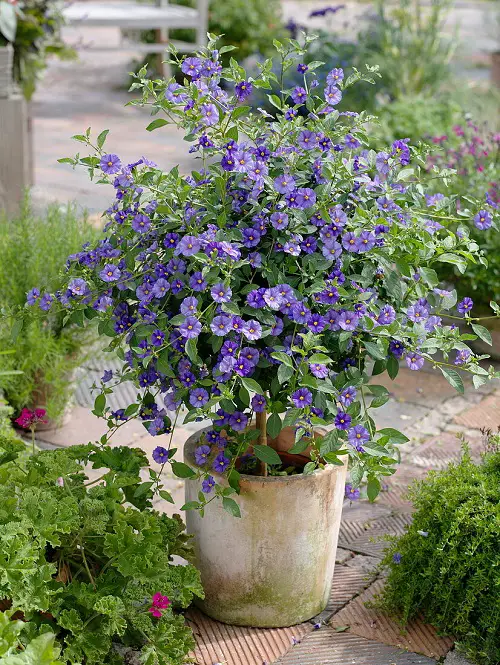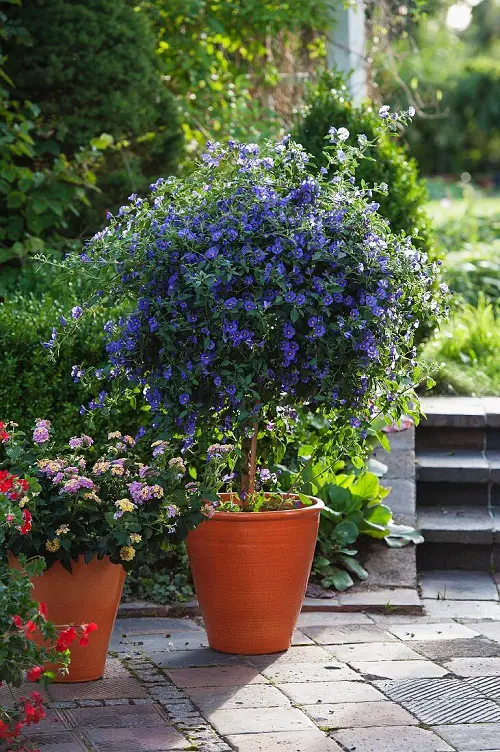Solanum Rantonnetii can stand out in your yard with its lovely foliage and scented blooms. Here’s all about growing Blue Potato Bush!
Solanum Rantonnetii is a stunning specimen with clusters of blue-purple flowers. It grows best in both pots and gardens, making it best for everyone with a small or big open space!
Find out the best blue fruits here
Solanum Rantonnetii Information
Mostly popular as Lycianthes rantonnetii, the blue potato bush (Solanum Rantonnetii) belongs to Argentina, Brazil, Paraguay, and Bolivia. It is famous worldwide for its subtle aromatic deep purple-blue blooms with yellow centers. This nightshade family plant has also won the Royal Horticultural Society’s prestigious Award of Garden Merit.
It features elliptical to oval, large leaves and purple-blue blooms that appear in March-October or year-round in warm regions. This shrub flowers profusely in summer. The orange-red oval berries are inedible and poisonous.
Propagating Solanum Rantonnetii
Instead of growing blue potato bush from the seeds of poisonous berries, propagating it from cuttings will be safe and easy.
Cut a 5-6 inches long stem below the leaf node and plant it in a pot with well-draining soil. Water well, cover it with a plastic bag, and keep it where it gets plenty of bright but indirect light.
Learn about growing cashew trees here
Best Blue Potato Bush Varieties
- Lycianthes rantonnetii ‘White’: It offers lovely scented snow-white blooms
- Lycianthes rantonnetii ‘Variegata’: This plant displays cream and grey-green foliage with sweet fragrant blue.
Growing Solanum Rantonnetii in Pots
You can grow blue potato bush easily in an 8-12 inches pot and keep it on a balcony, patio, or any small space. Keep re-potting the plant once in 1-2 years into one size bigger container, depending on the growth and spread.
Find out how to grow Never Never plants here
Requirements for Growing Solanum Rantonnetii

Location
Like all flowers, the best way to ensure this plant blooms at its best is to put it in a location that gets a minimum of 5-6 hours of intense and direct sunlight.
Avoid growing it at a spot that gets shade for the most part of the day, as it will result in fewer or no flowers.
Soil
Though Solanum Rantonnetii is not fussy regarding the growing medium, it would be wise to use well-draining soil. Amend it with a handful of sand, organic matter, and compost for bigger-size blooms.
Watering
Keeping the soil slightly on the moist side will help the plant grow and bloom better. To do this, water when the topsoil feels a little dry to the touch.
Do not water the plant daily, and also ensure that the soil never goes dry completely.
Learn the top Portulaca growing tips here
Blue Potato Bush Care

Fertilizer
Use a balanced liquid fertilizer, diluted to 1/2 its strength, once in 5-6 weeks. This will promote the size and color of the blooms.
Pruning
If you avoid pruning, the branches may take an arching pattern and will sprawl here and there. Start pruning in the winter after the plant stops flowering.
Snip lightly during this time; not more than one-third of each stem. While doing so, ensure you give it a clean and nice shape!
Overwintering
If you have grown the blue potato bush in pots, move them indoors before the frost reaches your area.
Pests and Diseases
This shrub is vulnerable to pests like caterpillars, thrips, and aphids. Use neem and horticultural oil or spinosad.
The blue potato bush can be affected by stem rot, blight, powdery mildew, gray mold, and viruses. To avoid these issues, do not overwater, keep the plant in plenty of bright light, and ensure it gets proper air circulation.




where can I buy seeds of solanum Rantonnetii ( Lycianthus Rantonnettii)